Comparative Proteomic Analysis of Aqueous Humor, Anterior Lens Capsules, and Crystalline Lenses in Different Human Cataract Subtypes Versus Healthy Controls
Abstract
1. Introduction
2. Materials and Methods
2.1. Human Subjects
2.2. Sample Collection
2.3. Sample Preparation
2.4. Liquid Chromatography–Tandem Mass Spectrometry (LC-MS/MS)
2.5. Data Processing Protocol
2.6. Statistical Analysis
3. Results
3.1. Participant Characteristics
3.2. Gene Enrichment Analysis
3.2.1. Aqueous Humor Samples
3.2.2. Anterior Capsule Samples
3.2.3. Phaco Cassette Content Samples
4. Discussion
5. Conclusions
6. Limitations
Supplementary Materials
Author Contributions
Funding
Institutional Review Board Statement
Informed Consent Statement
Data Availability Statement
Acknowledgments
Conflicts of Interest
References
- Mencucci, R.; Stefanini, S.; Favuzza, E.; Cennamo, M.; De Vitto, C.; Mossello, E. Beyond vision: Cataract and health status in old age, a narrative review. Front. Med. 2023, 10, 1110383. [Google Scholar] [CrossRef]
- Nizami, A.A.; Gurnani, B.; Gulani, A.C. Cataract. In Principles and Practice in Ophthalmic Assisting: A Comprehensive Textbook; StatPearls Publishing: Treasure Island, FL, USA, 2024; pp. 511–522. [Google Scholar] [CrossRef]
- Pietrowska, K.; Dmuchowska, D.A.; Krasnicki, P.; Mariak, Z.; Kretowski, A.; Ciborowski, M. Analysis of pharmaceuticals and small molecules in aqueous humor. J. Pharm. Biomed. Anal. 2018, 159, 23–36. [Google Scholar] [CrossRef] [PubMed]
- Dmuchowska, D.A.; Pietrowska, K.; Krasnicki, P.; Kowalczyk, T.; Misiura, M.; Grochowski, E.T.; Mariak, Z.; Kretowski, A.; Ciborowski, M. Metabolomics Reveals Differences in Aqueous Humor Composition in Patients With and Without Pseudoexfoliation Syndrome. Front. Mol. Biosci. 2021, 8, 682600. [Google Scholar] [CrossRef] [PubMed]
- Danysh, B.P.; Duncan, M.K. The Lens Capsule. Exp. Eye Res. 2008, 88, 151. [Google Scholar] [CrossRef] [PubMed]
- Danysh, B.P.; Patel, T.P.; Czymmek, K.J.; Edwards, D.A.; Wang, L.; Pande, J.; Duncan, M.K. Characterizing molecular diffusion in the lens capsule. Matrix Biol. 2009, 29, 228–236. [Google Scholar] [CrossRef]
- Truscott, R.J.W.; Friedrich, M.G. The etiology of human age-related cataract. Proteins don’t last forever. Biochim. Biophys. Acta (BBA)-Gen. Subj. 2016, 1860, 192–198. [Google Scholar] [CrossRef]
- Li, J.; Buonfiglio, F.; Zeng, Y.; Pfeiffer, N.; Gericke, A. Oxidative Stress in Cataract Formation: Is There a Treatment Approach on the Horizon? Antioxidants 2024, 13, 1249. [Google Scholar] [CrossRef]
- Kiziltoprak, H.; Tekin, K.; Inanc, M.; Goker, Y.S. Cataract in diabetes mellitus. World J. Diabetes 2019, 10, 140. [Google Scholar] [CrossRef]
- Holekamp, N.M.; Shui, Y.B.; Beebe, D.C. Vitrectomy surgery increases oxygen exposure to the lens: A possible mechanism for nuclear cataract formation. Am. J. Ophthalmol. 2005, 139, 302–310. [Google Scholar] [CrossRef]
- Beebe, D.C.; Holekamp, N.M.; Siegfried, C.; Shui, Y.B. Vitreoretinal influences on lens function and cataract. Philos. Trans. R. Soc. B Biol. Sci. 2011, 366, 1293. [Google Scholar] [CrossRef]
- Graves, P.R.; Haystead, T.A.J. Molecular biologist’s guide to proteomics. Microbiol. Mol. Biol. Rev. 2002, 66, 39–63. [Google Scholar] [CrossRef]
- Li, J.; Smith, L.S.; Zhu, H.J. Data-independent acquisition (DIA): An emerging proteomics technology for analysis of drug-metabolizing enzymes and transporters. Drug Discov. Today Technol. 2021, 39, 49. [Google Scholar] [CrossRef]
- Schey, K.L.; Wang, Z.; Friedrich, M.G.; Truscott, R.J.W. New insights into the mechanisms of age-related protein-protein crosslinking in the human lens. Exp. Eye Res. 2021, 209, 108679. [Google Scholar] [CrossRef] [PubMed]
- Schey, K.L.; Wang, Z.; Friedrich, M.G.; Garland, D.L.; Truscott, R.J.W. Spatiotemporal Changes in the Human Lens Proteome: Critical Insights into Long-lived Proteins. Prog. Retin. Eye Res. 2020, 76, 100802. [Google Scholar] [CrossRef] [PubMed]
- Schmid, P.W.N.; Lim, N.C.H.; Peters, C.; Back, K.C.; Bourgeois, B.; Pirolt, F.; Richter, B.; Peschek, J.; Puk, O.; Amarie, O.V.; et al. Imbalances in the eye lens proteome are linked to cataract formation. Nat. Struct. Mol. Biol. 2021, 28, 143–151. [Google Scholar] [CrossRef] [PubMed]
- Antonietti, M.; Kim, C.K.; Djulbegovic, M.B.; Gonzalez, D.J.T.; Greenfield, J.A.; Uversky, V.N.; Gibbons, A.G.; Karp, C.L. Effects of Aging on Intrinsic Protein Disorder in Human Lenses and Zonules. Cell Biochem. Biophys. 2024, 82, 3667–3679. [Google Scholar] [CrossRef]
- Karakosta, C.; Samiotaki, M.; Bisoukis, A.; Bougioukas, K.I.; Panayotou, G.; Papaconstantinou, D.; Moschos, M.M. Differential Signaling Pathways Identified in Aqueous Humor, Anterior Capsule, and Crystalline Lens of Age-Related, Diabetic, and Post-Vitrectomy Cataract. Proteomes 2025, 13, 7. [Google Scholar] [CrossRef]
- Kanthan, G.L.; Mitchell, P.; Rochtchina, E.; Cumming, R.G.; Wang, J.J. Myopia and the long-term incidence of cataract and cataract surgery: The Blue Mountains Eye Study. Clin. Exp. Ophthalmol. 2014, 42, 347–353. [Google Scholar] [CrossRef]
- KEGG PATHWAY Database. Available online: https://www.genome.jp/kegg/pathway.html (accessed on 3 February 2025).
- Chong, C.C.W.; Stump, R.J.W.; Lovicu, F.J.; McAvoy, J.W. TGFβ promotes Wnt expression during cataract development. Exp. Eye Res. 2008, 88, 307. [Google Scholar] [CrossRef]
- MacDonald, B.T.; Tamai, K.; He, X. Wnt/β-catenin signaling: Components, mechanisms, and diseases. Dev. Cell 2009, 17, 9. [Google Scholar] [CrossRef]
- MacDonald, B.T.; He, X. Frizzled and LRP5/6 Receptors for Wnt/β-Catenin Signaling. Cold Spring Harb. Perspect. Biol. 2012, 4, 7880–7881. [Google Scholar] [CrossRef]
- Wang, P.; Li, Y.-W.; Lu, X.; Liu, Y.; Tian, X.-L.; Gao, L.; Liu, Q.-J.; Fan, L.; Tian, M. Low-dose ionizing radiation: Effects on the proliferation and migration of lens epithelial cells via activation of the Wnt/β-catenin pathway. Mutat. Res. Genet. Toxicol. Environ. Mutagen. 2023, 888, 503637. [Google Scholar] [CrossRef] [PubMed]
- Chen, Y.; Stump, R.J.W.; Lovicu, F.J.; McAvoy, J.W. A role for Wnt/Planar Cell Polarity signaling during lens fiber cell differentiation? Semin. Cell Dev. Biol. 2006, 17, 712. [Google Scholar] [CrossRef] [PubMed]
- Chong, C.C.W.; Ang, S.L.; Stump, R.J.W.; Lovicu, F.J.; McAvoy, J.W. Wnt Expression in TGFß–induced Cataract Models. Investig. Ophthalmol. Vis. Sci. 2004, 45, 2654. [Google Scholar]
- Glycolipid Composition of Human Cataractous Lenses. Characterization of Lewisx Glycolipids—PubMed. Available online: https://pubmed.ncbi.nlm.nih.gov/7905480/ (accessed on 24 October 2025).
- Rao, P.V.; Maddala, R. The Role of the Lens Actin Cytoskeleton in Fiber Cell Elongation and Differentiation. Semin. Cell Dev. Biol. 2006, 17, 698. [Google Scholar] [CrossRef]
- Karakosta, C.; Samiotaki, M.; Panayotou, G.; Papaconstantinou, D.; Moschos, M.M. Proteomic Changes of Glycolipid Pathways in Age-Related, Diabetic, and Post-Vitrectomy Cataracts. J. Clin. Med. 2024, 13, 7287. [Google Scholar] [CrossRef]
- Song, S.; Landsbury, A.; Dahm, R.; Liu, Y.; Zhang, Q.; Quinlan, R.A. Functions of the intermediate filament cytoskeleton in the eye lens. J. Clin. Investig. 2009, 119, 1837–1848. [Google Scholar] [CrossRef]
- Jakobs, P.M.; Hess, J.F.; FitzGerald, P.G.; Kramer, P.; Weleber, R.G.; Litt, M. Autosomal-dominant congenital cataract associated with a deletion mutation in the human beaded filament protein gene BFSP2. Am. J. Hum. Genet. 2000, 66, 1432–1436. [Google Scholar] [CrossRef]
- Sandilands, A.; Prescott, A.R.; Wegener, A.; Zoltoski, R.K.; Hutcheson, A.M.; Masaki, S.; Kuszak, J.R.; Quinlan, R.A. Knockout of the intermediate filament protein CP49 destabilises the lens fibre cell cytoskeleton and decreases lens optical quality, but does not induce cataract. Exp. Eye Res. 2003, 76, 385–391. [Google Scholar] [CrossRef]
- Cosar, B.; Nefesoglu, M.S.; Altinoz, M.A.; Akgun, E.; Sahin, B.; Baykal, A.; Serteser, M. Lens Proteomics Provide Novel Clues for Cataractogenesis: Original Investigation and a Broad Literature Survey. J. Clin. Med. 2025, 14, 4737. [Google Scholar] [CrossRef]
- Beyer, E.C.; Mathias, R.T.; Berthoud, V.M. Loss of fiber cell communication may contribute to the development of cataracts of many different etiologies. Front. Physiol. 2022, 13, 989524. [Google Scholar] [CrossRef] [PubMed]
- Beebe, D.C.; Parmelee, J.T.; Belcher, K.S. Volume regulation in lens epithelial cells and differentiating lens fiber cells. J. Cell Physiol. 1990, 143, 455–459. [Google Scholar] [CrossRef] [PubMed]
- Ramaekers, F.; Jap, P.; Mungyer, G.; Bloemendal, H. Microfilament assembly during lens cell elongation in vitro. Curr. Eye Res. 1982, 2, 169–181. [Google Scholar] [CrossRef] [PubMed]
- Karakosta, C.; Samiotaki, M.; Panayotou, G.; Papakonstantinou, D.; Moschos, M.M. Role of actin-binding proteins in cataract formation. Cytoskeleton 2024, 82, 98–110. [Google Scholar] [CrossRef]
- Shu, D.Y.; Chaudhary, S.; Cho, K.-S.; Lennikov, A.; Miller, W.P.; Thorn, D.C.; Yang, M.; McKay, T.B. Role of Oxidative Stress in Ocular Diseases: A Balancing Act. Metabolites 2023, 13, 187. [Google Scholar] [CrossRef]
- Markatia, Z.; Hudson, J.; Leung, E.H.; Sajjad, A.; Gibbons, A. The Post Vitrectomy Cataract. Int. Ophthalmol. Clin. 2022, 62, 79. [Google Scholar] [CrossRef]
- Siegfried, C.J.; Shui, Y.B. Intraocular Oxygen and Antioxidant Status: New Insights on the Effect of Vitrectomy and Glaucoma Pathogenesis. Am. J. Ophthalmol. 2019, 203, 12. [Google Scholar] [CrossRef]
- Hubbard, E.E.; Shoff, T.A.; Hur, M.; Lambeth, T.R.; Chen, C.; Kung, E.; Pan, B.D.; Lui, M.K.; Linares, J.R.; Cantrell, L.S.; et al. Deep Characterization of Isomerization in the Human Eye Lens Proteome by Crystallin-Depleted Data-Independent Acquisition. Aging Cell 2025, 24, e70028. [Google Scholar] [CrossRef]
- Zelle, S.R.; McDonald, W.H.; Rose, K.L.; Mchaourab, H.S.; Schey, K.L. Data-Independent Acquisition Parallel Accumulation-Serial Fragmentation (diaPASEF) Analysis of the Separated Zebrafish Lens Improves Identifications. J. Am. Soc. Mass Spectrom. 2025, 36, 1503–1509. [Google Scholar] [CrossRef]
- Wang, Z.; Friedrich, M.G.; Truscott, R.J.W.; Schey, K.L. Identification of Age- and Cataract-Related Changes in High-Density Lens Protein Aggregates. Investig. Ophthalmol. Vis. Sci. 2025, 66, 34. [Google Scholar] [CrossRef]
- Cantrell, L.S.; Gletten, R.B.; Schey, K.L. Proteome Remodeling of the Eye Lens at 50 Years Identified With Data-Independent Acquisition. Mol. Cell Proteom. 2023, 22, 100453. [Google Scholar] [CrossRef]
- Schey, K.L.; Wang, Z.; Rose, K.L.; Anderson, D.M.G. Imaging Cataract-Specific Peptides in Human Lenses. Cells 2022, 11, 4042. [Google Scholar] [CrossRef]
- Deutsch, E.W.; Bandeira, N.; Perez-Riverol, Y.; Sharma, V.; Carver, J.J.; Mendoza, L.; Kundu, D.J.; Wang, S.; Bandla, C.; Kamatchinathan, S.; et al. The ProteomeXchange consortium at 10 years: 2023 update. Nucleic Acids Res. 2023, 51, D1539. [Google Scholar] [CrossRef]
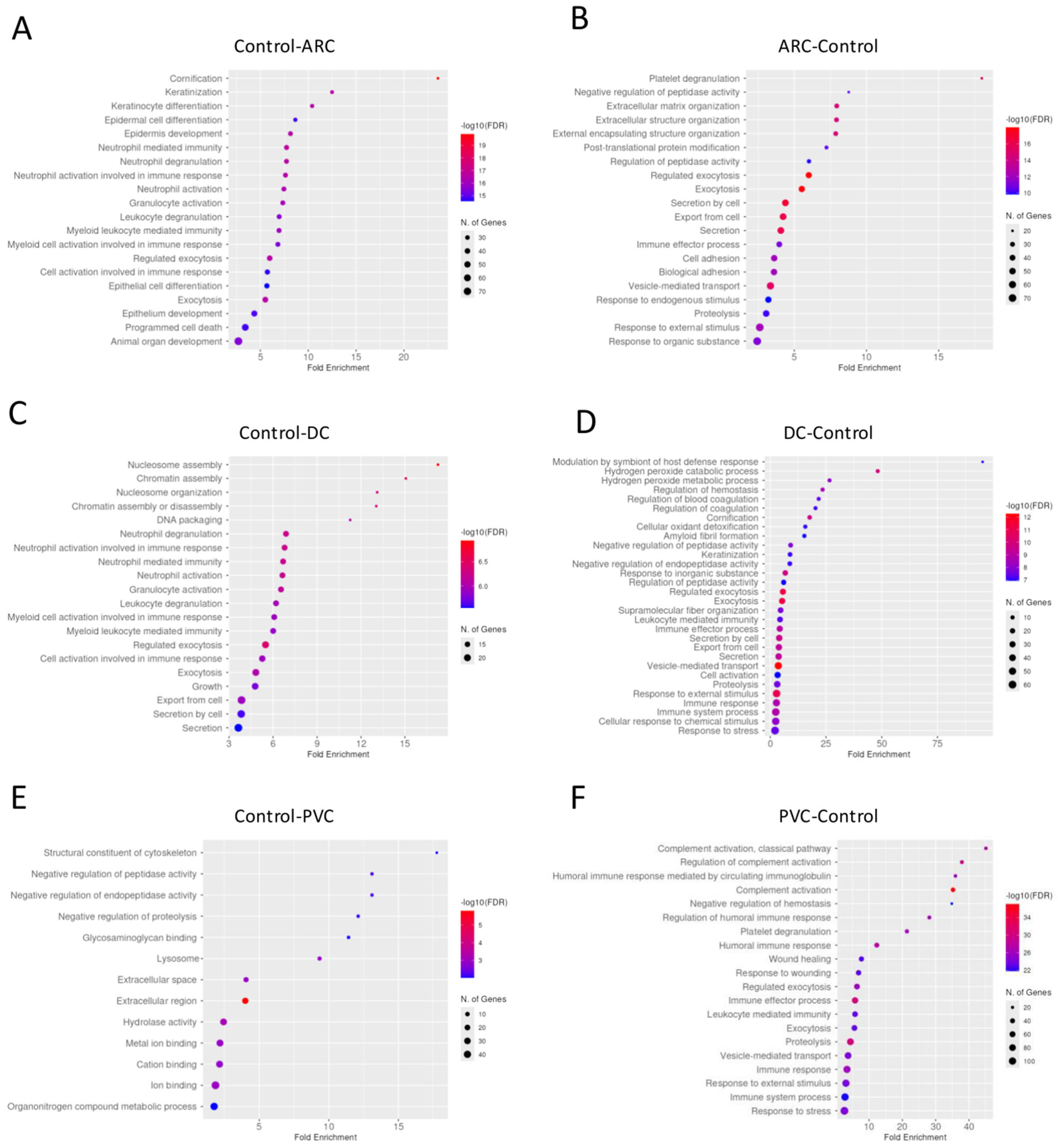
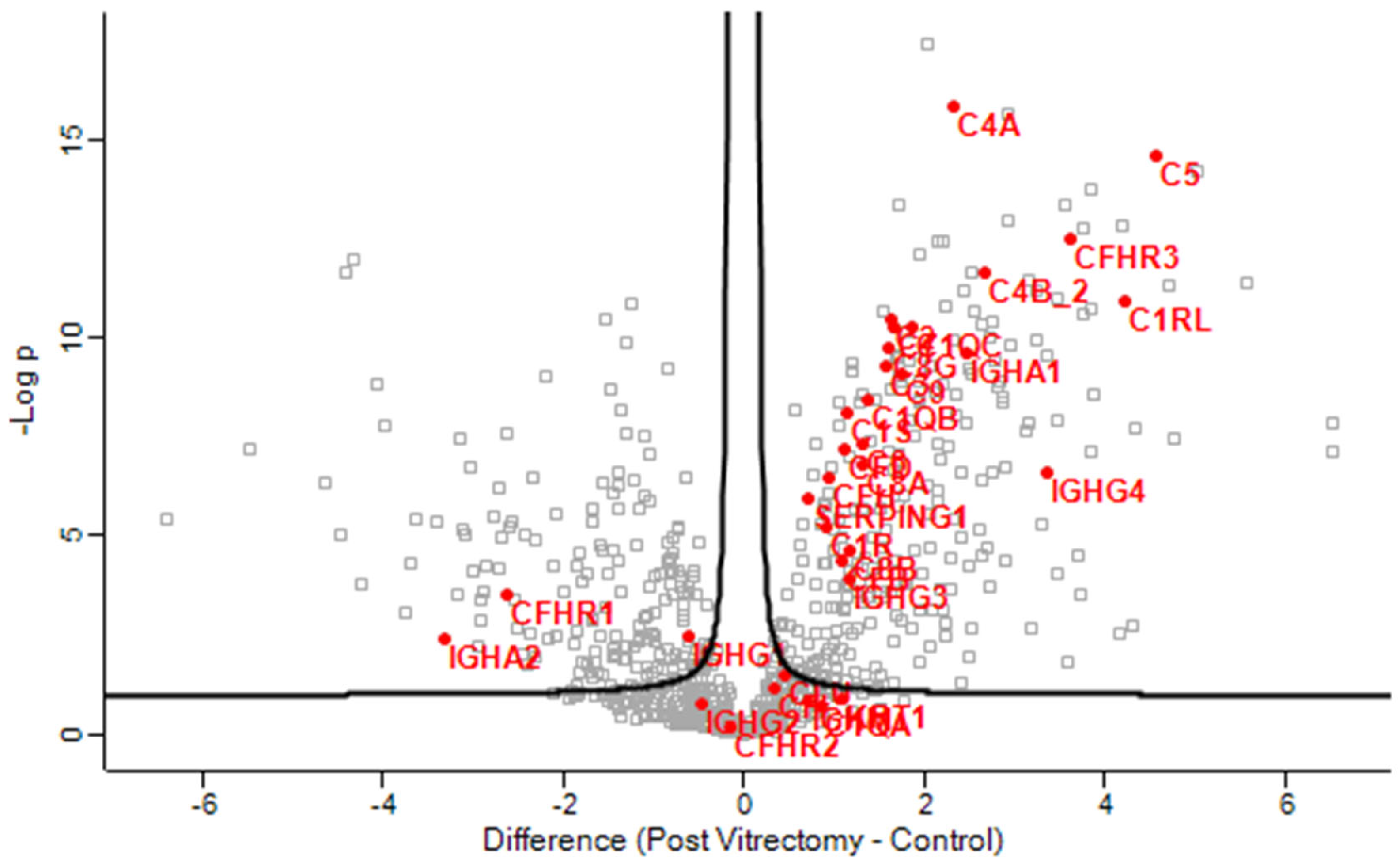

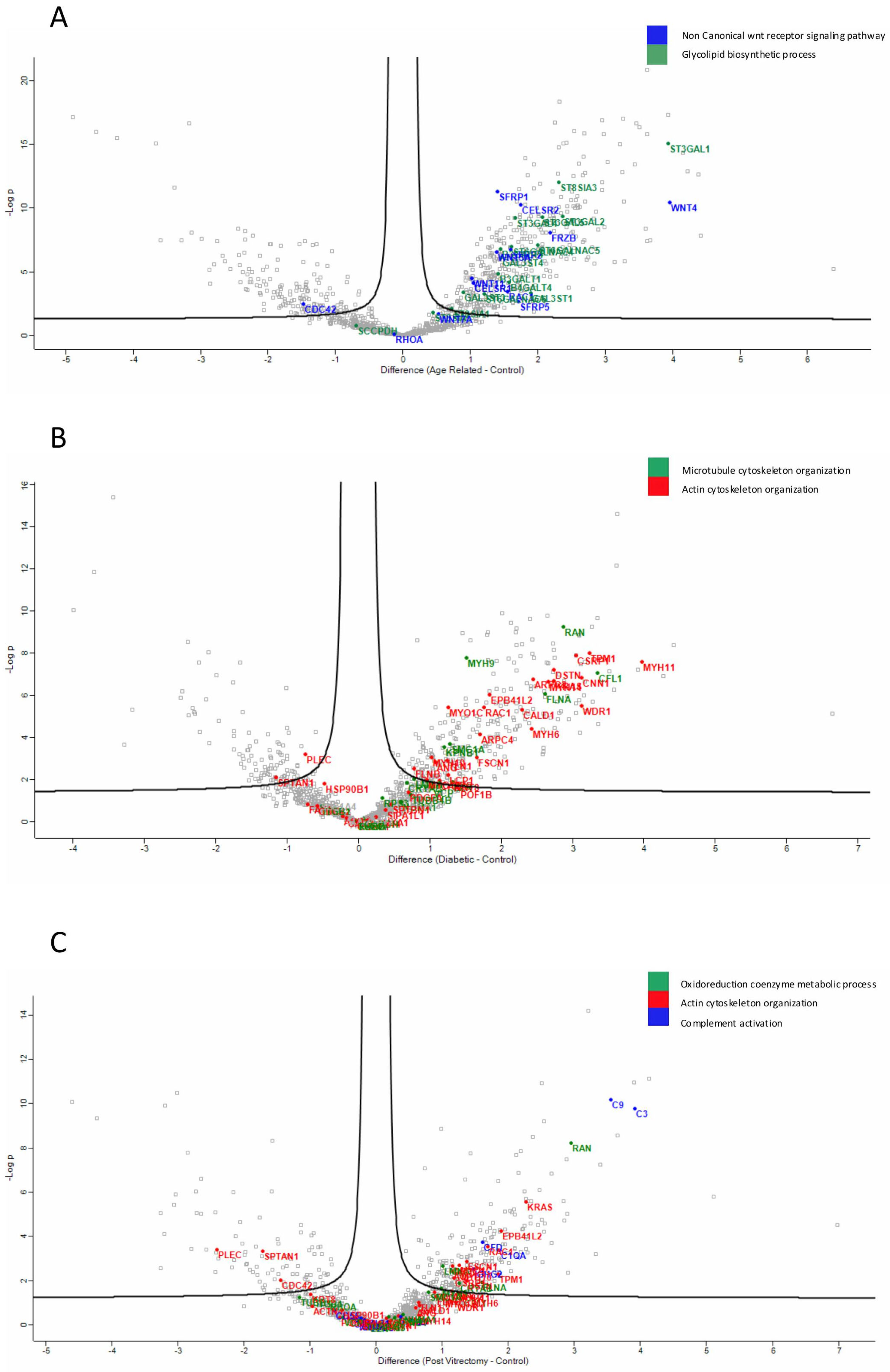
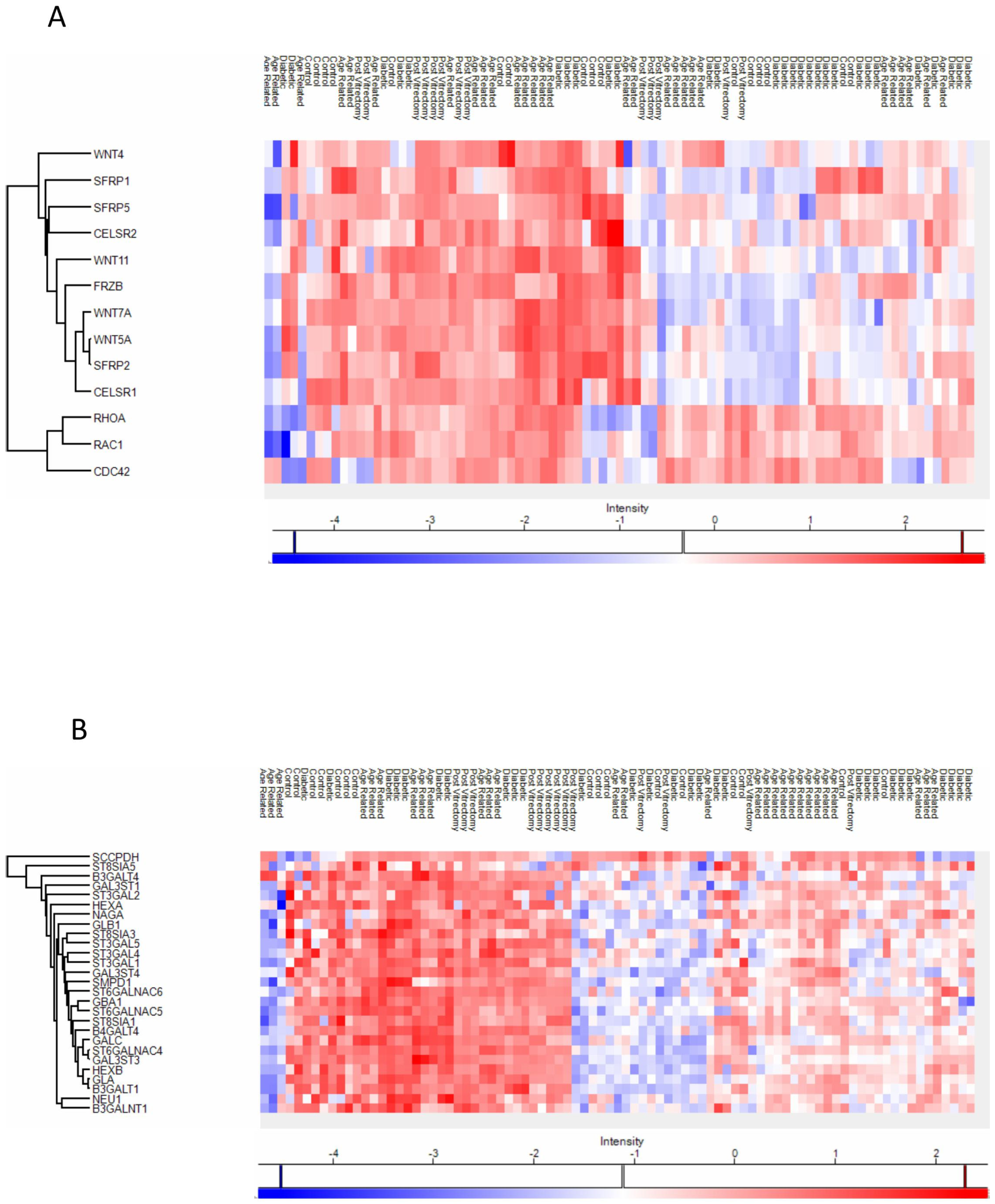



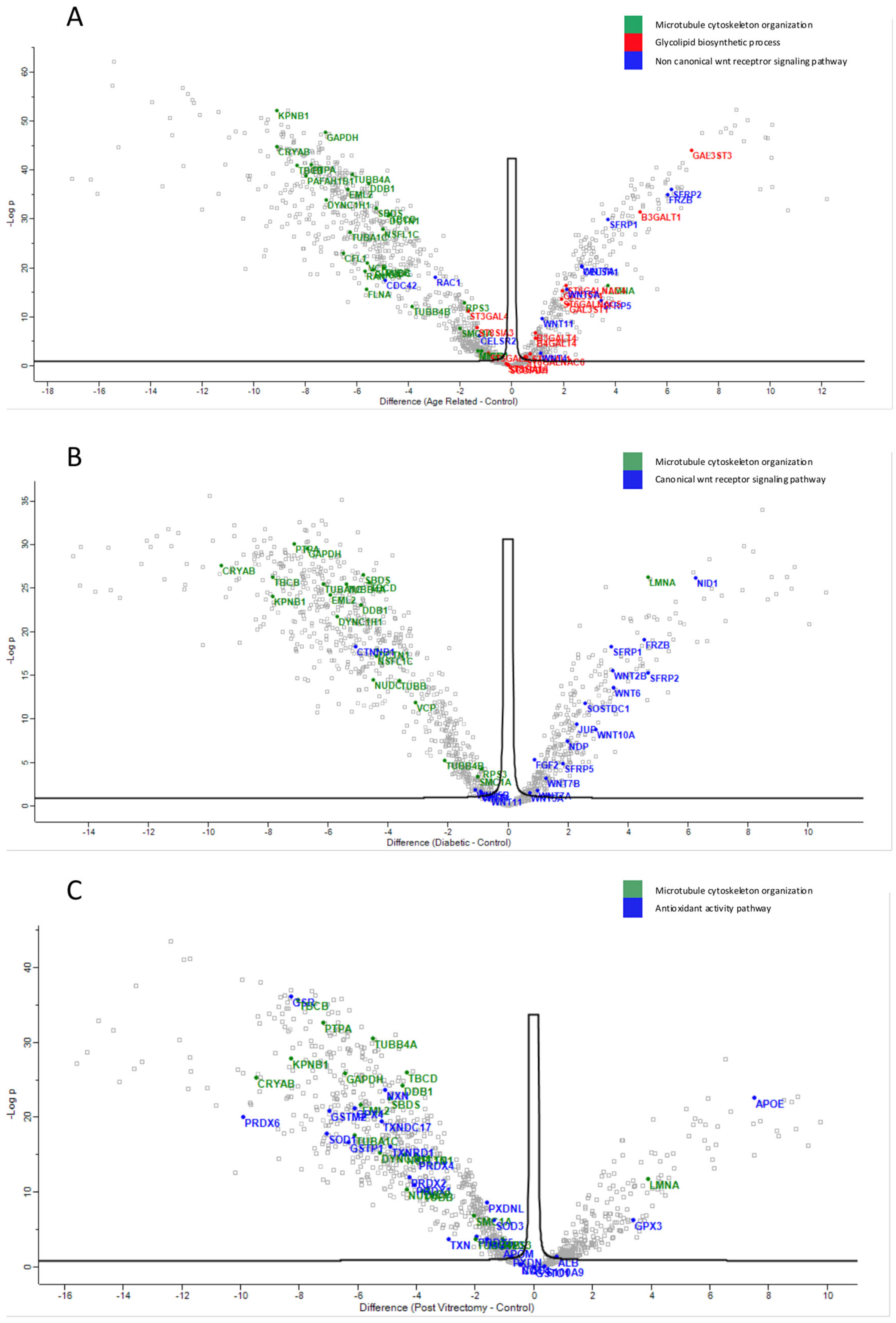
| ARC Group | DC Group | PVC Group | Control Group | |
|---|---|---|---|---|
| Subjects | 12 | 11 | 7 | 9 |
| Mean age (years, mean ± SD) | 79.6 ± 4.2 | 61.7 ± 4.3 | 60 ± 10.2 | 56 ± 3.3 |
| Sex (male/female) | 5:7 | 7:4 | 2:5 | 4:5 |
| OD:OS | 6:6 | 7:4 | 1:6 | 7:2 |
| Dominant type of cataract (NS:CS:PSC) | 8:2:2 | 5:1:5 | 3:0:4 | N/A |
| Mean height (cm, mean ± SD) | 164.08 ± 9.98 | 171.45 ± 7.13 | 168.88 ± 7.08 | 173.56 ± 7.94 |
| Mean weight (kg, mean ± SD) | 70.58 ± 13.75 | 94.55 ± 6.82 | 77.88 ± 13.35 | 74.11 ± 13.63 |
| Mean AL (mm, mean ± SD) | 23.69 ± 0.97 | 23.10 ± 0.80 | 24.52 ± 1.49 | 21.73 ± 1.22 |
| Mean K1 (D, mean ± SD) | 42.89 ± 1.44 | 43.02 ± 0.64 | 41.51 ± 1.51 | 42.06 ± 0.55 |
| Mean K2 (D, mean ± SD) | 43.58 ± 1.55 | 44.17 ± 0.79 | 42.65 ± 1.61 | 42.87 ± 0.87 |
| Mean sun exposure (hours, mean ± SD) | 2.2 ± 1.5 | 3.5 ± 2.5 | 4.3 ± 2.4 | 1.0 ± 1.32 |
| Use of sunglasses (Yes/No) | 6:6 | 7:4 | 3:4 | 7:2 |
| Iris color (brown/hazel/blue) | 9:3:0 | 8:2:1 | 5:1:1 | 9:0:0 |
| Smoking (Yes/No) | 3:9 | 4:7 | 0:7 | 7:2 |
| Alcohol consumption (Yes/No) | 2:10 | 1:10 | 0:7 | 8:1 |
| Hypertension (Yes/No) | 7:5 | 2:9 | 4:3 | 8:1 |
| Glaucoma (Yes/No) | 1:11 | 0:11 | 0:7 | 0:9 |
| Aspirin intake (Yes/No) | 1:11 | 1:10 | 0:7 | 3:6 |
| AMD (Yes/No) | 4:8 | 0:11 | 0:7 | 0:9 |
| Thyroid disease (Yes/No) | 3:9 | 2:9 | 0:7 | 0:9 |
| Diet supplementary intake (Yes/No) | 5:7 | 3:8 | 1:6 | 3:6 |
Disclaimer/Publisher’s Note: The statements, opinions and data contained in all publications are solely those of the individual author(s) and contributor(s) and not of MDPI and/or the editor(s). MDPI and/or the editor(s) disclaim responsibility for any injury to people or property resulting from any ideas, methods, instructions or products referred to in the content. |
© 2025 by the authors. Licensee MDPI, Basel, Switzerland. This article is an open access article distributed under the terms and conditions of the Creative Commons Attribution (CC BY) license (https://creativecommons.org/licenses/by/4.0/).
Share and Cite
Karakosta, C.; Samiotaki, M.; Bisoukis, A.; Bougioukas, K.I.; Panayotou, G.; Kyriakidou, N.; Moschou, K.; Moschos, M.M. Comparative Proteomic Analysis of Aqueous Humor, Anterior Lens Capsules, and Crystalline Lenses in Different Human Cataract Subtypes Versus Healthy Controls. Proteomes 2025, 13, 62. https://doi.org/10.3390/proteomes13040062
Karakosta C, Samiotaki M, Bisoukis A, Bougioukas KI, Panayotou G, Kyriakidou N, Moschou K, Moschos MM. Comparative Proteomic Analysis of Aqueous Humor, Anterior Lens Capsules, and Crystalline Lenses in Different Human Cataract Subtypes Versus Healthy Controls. Proteomes. 2025; 13(4):62. https://doi.org/10.3390/proteomes13040062
Chicago/Turabian StyleKarakosta, Christina, Martina Samiotaki, Anastasios Bisoukis, Konstantinos I. Bougioukas, George Panayotou, Nantieznta Kyriakidou, Konstantinos Moschou, and Marilita M. Moschos. 2025. "Comparative Proteomic Analysis of Aqueous Humor, Anterior Lens Capsules, and Crystalline Lenses in Different Human Cataract Subtypes Versus Healthy Controls" Proteomes 13, no. 4: 62. https://doi.org/10.3390/proteomes13040062
APA StyleKarakosta, C., Samiotaki, M., Bisoukis, A., Bougioukas, K. I., Panayotou, G., Kyriakidou, N., Moschou, K., & Moschos, M. M. (2025). Comparative Proteomic Analysis of Aqueous Humor, Anterior Lens Capsules, and Crystalline Lenses in Different Human Cataract Subtypes Versus Healthy Controls. Proteomes, 13(4), 62. https://doi.org/10.3390/proteomes13040062







